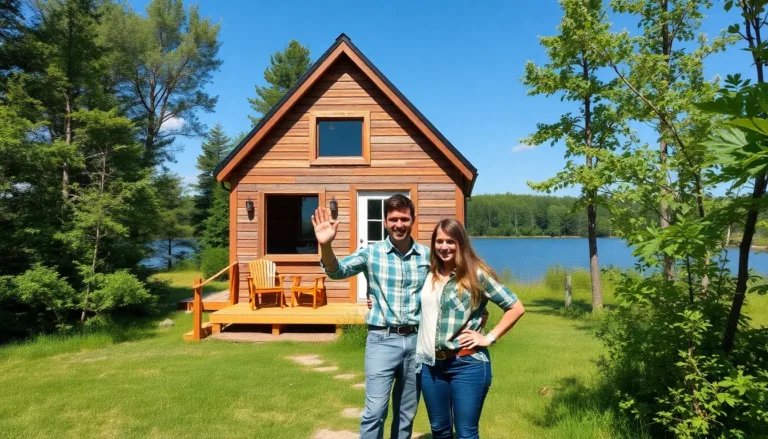Table of Contents
ToggleBuying a home is like dating—everyone wants to find “the one,” but first, you’ve got to impress with a solid down payment. That initial investment can feel like a mountain to climb, but it’s the key to unlocking your dream home. After all, who wouldn’t want to trade rent checks for a cozy living room that’s all theirs?
Understanding Home Down Payments
A home down payment represents a percentage of the purchase price paid upfront, crucial for obtaining a mortgage. Typically, this amount ranges from 3% to 20%, depending on the loan type and lender.
What Is a Home Down Payment?
A down payment functions as an initial investment in a home. It reflects the buyer’s commitment and financial stability. Buyers with higher down payments often secure better mortgage terms, including lower interest rates. Understanding what constitutes a down payment aids in financial planning, especially regarding long-term homeownership.
Importance of a Down Payment
A significant down payment lowers the purchased home’s overall loan amount. It reduces monthly mortgage payments, making housing more affordable. Additionally, a substantial down payment builds equity quickly, providing financial security and flexibility in the future. It also demonstrates to lenders that buyers are responsible and financially prepared, potentially leading to improved loan options.
Types of Down Payments

Understanding the types of down payments can help buyers make informed decisions. Each type caters to different financial situations and qualifications.
Conventional Loans
Conventional loans typically require a down payment of 3% to 20%. Buyers with a down payment of less than 20% often face private mortgage insurance (PMI) costs. Having a higher down payment can lead to lower interest rates and better loan terms. Lenders evaluate the buyer’s credit score, income, and financial stability when considering the loan. An excellent credit score increases the likelihood of securing favorable conditions.
FHA Loans
FHA loans, backed by the Federal Housing Administration, allow down payments as low as 3.5%. These loans cater to first-time homebuyers or those with lower credit scores. A borrower with a credit score of 580 or higher qualifies for the 3.5% down payment. Mortgage insurance premiums apply with FHA loans, influencing the overall cost. FHA loans expand homeownership opportunities, making them an attractive option for many buyers.
VA Loans
VA loans offer significant benefits for eligible veterans and active-duty service members. Zero down payment is a key advantage of VA loans, which reduces upfront costs. No private mortgage insurance is required, lowering monthly payments. This loan type demonstrates the government’s commitment to supporting those who serve the country. The funding fee, a one-time charge, may apply but can be rolled into the loan.
Saving for a Down Payment
Saving for a down payment requires careful planning and disciplined execution. Buyers benefit from establishing clear savings goals tailored to their desired home price.
Setting a Savings Goal
Setting a savings goal involves calculating how much is needed for a down payment based on the home’s purchase price. A common target ranges from 3% to 20%. For instance, on a $300,000 home, a 20% down payment equals $60,000. He or she can determine their timeline by dividing the total savings goal by the number of months until purchase. Creating a milestone chart can keep individuals motivated by tracking progress towards their target.
Budgeting for Your Down Payment
Budgeting for a down payment starts with evaluating current expenses and income. Identifying areas to cut costs can free up additional funds for savings. Allocating a specific percentage of monthly income towards a savings account proves effective. Using high-yield savings accounts or other interest-bearing options can increase savings faster. Regular assessments of budget categories help individuals adjust as necessary and stay aligned with their down payment goals.
Down Payment Assistance Programs
Down payment assistance programs offer crucial support for homebuyers. Various options exist to help bridge the financial gap.
Government Programs
Government programs provide substantial resources for eligible buyers. Programs like the HomePath Ready Buyer Program offer up to 3% in closing cost assistance. State and local governments also have assistance initiatives that create homeownership opportunities. For instance, many states run down payment assistance programs designed for low to moderate-income families, often offering grants or forgivable loans. Buyers should check their state housing agency websites for specific details.
Nonprofit Organizations
Nonprofit organizations play a vital role in supporting homebuyers through down payment programs. Groups like Habitat for Humanity focus on building affordable homes and can assist with down payments. Others, such as the National Homebuyers Fund, provide grants and down payment assistance directly. These organizations often collaborate with local governments to expand their impact, offering workshops and resources that educate potential homeowners about the buying process and available financial aid. Homebuyers can access valuable information and support by reaching out to these nonprofits.
Impact of Down Payment on Home Buying
A home down payment significantly influences both the purchasing process and financial outcomes for buyers. The amount paid upfront can affect various aspects of homeownership.
Lowering Monthly Payments
Making a larger down payment directly reduces the loan amount, which lowers monthly payments. For instance, a 20% down payment on a $300,000 home results in a $240,000 mortgage instead of a $270,000 balance with a 10% down payment. Buyers often appreciate the relief of smaller monthly obligations, making budgeting easier. Lower payments facilitate financial freedom and allow homeowners to allocate funds toward other priorities, such as savings or investments. A reduced mortgage amount also contributes to overall interest savings throughout the loan term.
Avoiding Private Mortgage Insurance (PMI)
Opting for a larger down payment helps buyers avoid the additional cost of private mortgage insurance, or PMI. Lenders typically require PMI for down payments below 20% to protect themselves from default risk. For example, a borrower putting down 10% on a $300,000 home may incur monthly PMI costs ranging from $150 to $300. Eliminating this expense not only improves monthly cash flow but also enhances the potential for building equity sooner. Many buyers find it advantageous to maintain a budget that supports a higher down payment to achieve this financial benefit.
Achieving the dream of homeownership starts with understanding the significance of a down payment. It’s not just a financial obligation but a key factor that influences mortgage terms and overall affordability. By saving diligently and exploring various assistance programs, potential buyers can make homeownership a reality.
Every dollar saved brings them closer to their goal and opens doors to better options. A strong down payment reflects commitment and financial readiness, paving the way for a stable future. With careful planning and smart budgeting, homebuyers can navigate the journey toward owning their ideal home with confidence.







